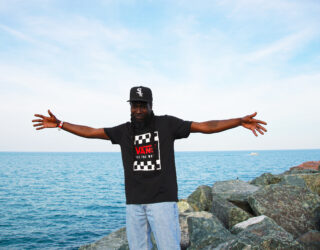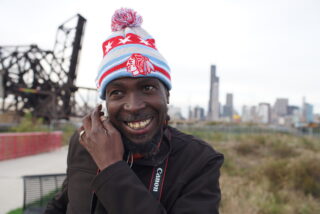RP Boo: “The reason I’m here is I’m not afraid to step out of the box”
Mapping out the evolution of footwork, one of the most radical dance music genres of the 21st century, with a true pioneer

Mapping out the evolution of footwork, one of the most radical dance music genres of the 21st century, with a true pioneer
RP Boo operates on his own terms. Alongside the likes of DJ Rashad and DJ Clent, he jumpstarted footwork, a genre of rhythmically complex dance music that originated in Chicago. The style went on to pique international interest in the late 2000s, and to this day he remains one of the most singular producers to emerge from the scene.
2023 sees the release of Legacy Volume 2 on Planet Mu, a compilation of classic tracks and lost gems. The project marks the ten-year anniversary of his first release with the label, who themselves helped introduce the sound to the wider world. I sit down with the man behind the moniker, Kavain Wayne Space, to discuss how it all came to be.
He has an endearing manner, enthusiastically regaling me with tales with a mixture of wisdom and wonder. He traces his introduction to Planet Mu back to DJ Rashad, who was a key instigator of footwork’s international spread via his extensive touring. “I trusted in Planet Mu, by way of talking to Rashad, Space explains. “He was one of the first people to talk to me about the label. He always told people about all the other producers in Chicago that helped birth this.” Rashad tragically passed away in 2014, but his influence continues to loom large over the wider electronic world.
Space’s debut album Legacy was released in 2010, a quasi-compilation made up of old tracks and new, a defining document of early footwork. Legacy may seem a strange title for a debut full-length, but it was a sign of an industry playing catch-up. The errant footwork scene had been active in the Chicago underground since the late ’90s, mutating from ghetto house, itself a localised, rougher evolution of the city’s more conventional house music.
The solo release was a follow-up to the first Bangs and Works compilations that Planet Mu had released in 2010, itself the result of the connection made between Rashad and label manager Mike Paradinas. The two releases compiled reams of unknown artists from Chicago, a densely potent display of the anarchic and far-reaching possibilities of the genre. High-speed syncopated kick drums batter unrelentingly, while percussive hits land haphazardly and gonzo samples are hacked at mercilessly. The result is often jarring, a polyrhythmic mass that often marries sparse instrumentation with dense composition.

The true success of Bangs and Works lay in its highlighting of the individualistic nature of each artist, representing a fertile scene that held endless potential. Amongst those included was RP Boo, who seemed to exist within his own reality altogether. One of the highlights of the compilation series is his track ‘Eraser’, which rightfully reappears as the opener on Legacy Volume 2.
The track exudes pure nihilism, assembled from a staggering sub-bass rhythm, rigor mortis drones and antagonistic taunts such as “no holds barred, eraser” and “fuck dat, burn them all”. Its forebodingly glacial pace is at odds with the frantic speed the genre is known for.
The vocals echo the fervent trash talk Space witnessed at the legendary Chicago dance battles in which the sound of footwork first began to take shape, notably at events like War Zone. “There I met a whole set of West Side footworkers,” recalls Space. “Their style was crazy and I’d hear them talk crazy to each other. So I thought I’d make a track for them.”
The tone of the track seems to be a far cry from the man talking to me, beaming as he recounts its inception. But then there’s more to the track than throwaway threats and doom-mongering. The key sample is a loop of Paul McCartney, lifted from the Wings hit ‘Live and Let Die’. Macca’s croon is audaciously cut-and-pasted across the track, ducking and weaving the goading vocal jabs. The overall effect is disorientating, hostile and hilarious. Space mentions that originally the track instead featured a sample from a track by The Police; nothing was safe from his sampler. Though by no means a template for the rest of his work, ‘Eraser’ carries the hallmarks that make him such an outlier in his field.
I ask Space where his irreverent approach to sampling comes from. “My advantage is that I’m older,” he answers. “I was born in the ’70s, listening to the radio stations – James Brown, Earth, Wind & Fire, Led Zeppelin. Then as the ’80s rolls in: MTV. I’m just soaking it all up.”
It’s clear that there’s a respect for what he samples, though fortunately it’s the type of respect that still allows him to recontextualise sounds with reckless abandon. The humorous aspect of the results is not lost on him; if anything the audacity is another string to his bow. “I’d listen to the samples the hip hop producers were using – jazz, funk, rock. When it came my time to do it, I started pulling stuff out of memory lane. People were like, ‘How and why could he use this sample? And why didn’t I think about it first!’”
His time came during the peak of ghetto house, the street-level successor to Chicago’s greatest cultural export: house music. It was a stripped-back take on the original format; raw, direct and party-centric with vocals that veer from raunchy to downright vulgar. Space witnessed this transition first hand.
“I would say the birth of it was in the late ’80s, but it came into fruition in the ’90s, right after Cajmere [aka house legend Green Velvet] released ‘Percolator’.” He continues: “It was still so hidden underground. The tapes were flying around but to really hear it you’d have to go to the West Side of Chicago – a place called The Factory. That’s where people like Jammin Gerald, Houz’Mon and Quick Mix Claude were doing their thing. Then on the South Side, DJ Deeon and DJ Milton were the heavy hitters.” Space wasn’t producing yet, but he began making his name as a DJ – “Believe me, I stopped every party I went to!”
As the ’90s rolled on, ghetto house began to stagnate. “The tracks were getting very dry, and a lot of places had been shut down,” he notes. This saw a lot of the bigger names playing private raves, as well as being booked outside of the state. “But there was one place left, Club Cavallini, in the south suburbs of the city. That’s where the new generation went.”
That new generation included DJ Clent, who would soon go on to form Beatdown House alongside Majik Myke and DJ Rashad. “I was the last person that he came to,” acknowledges Space, “but the next thing you know, we started doing parties and creating tracks.”
Space had begun producing prior to joining Beatdown, but it was with the crew that he created what is considered the first true footwork track: ‘Baby Come On’. It was a freak mutation that defibrillated a tired formula. The vocal is a loop of Ol’ Dirty Bastard’s feature on Mariah Carey’s track ‘Fantasy’. Space claims the idea was lifted from a radio DJ who he’d heard a few years before, beat-juggling the vocal back and forth on a pair of records. But vocal samples were nothing new, “It was the rhythm of the beat. It was distinct,” explains Space. “If you take out the sample and just let the beat roll, it was something totally different. Then with the sample on top, it starts to juggle.” It’s a polyrhythmic cascade that persistently threatens to fall apart, catching itself at irregular intervals that jar and satisfy in equal measure. It was also an intriguing invitation to the more adventurous dancers in the crowd. “It just drove people crazy,” he reflects, adding that, “from that moment, everybody started changing their route. It was our chance to be heard. And they all took it and did their thing.”
The effect that these early tracks had on the crowd should not be understated. The spark that allowed the sound to grow was physical dancefloor combustion; as the music flourished, it soundtracked dance battles, with crews taking turns to showcase their unique abilities. The battles had existed prior to footwork, originating at underground talent shows separate from the regular clubs: “It was pure enjoyment. Every weekend. It went on for years, just people showing off their dance craft.” Eventually, as things progressed, the talent shows fizzled out and the battles shifted into the clubs. As the music developed, so did the dance, with emphasis on the lower body, the footwork.
On home turf, the sound and the bodily activity seemed inseparable, one and the same. But when the music eventually went international, the dance didn’t get a plane ticket. Space himself was a dancer, and still to this day he’ll vacate the DJ booth to demonstrate his moves for the crowd. I wondered how this separation sat with the originators. “When I played my first festival, Unsound, I seen people jump, I seen them dance how they wanna dance, but I didn’t see the actual footwork. I wasn’t used to it. But I’ve accepted it over the years: I’m here to present the music.”
Interestingly, as the music found an audience outside of Chicago, a reverse situation happened, with some of the dancers themselves finding commercial backing work for big name pop acts. I ask how the scene is on the ground in 2023.
“It’s changed again,” he says. “There’s sponsorship. There’s nationwide freeform dancing. They are seeing more opportunities. It’s changing for the better. They are learning to respect other dance styles.” Space says the only issue is that the dancers need to learn to leave some of the trash talk out of these more formal occasions.
With time moving as it does, the scene as it was is undoubtedly a thing of the past. Exposure will lead to fragmentation but also evolution, and through the likes of Planet Mu and Hyperdub some of the most radical electronic musicians of the past decade have flourished from the footwork underground, with artists like Jlin abstracting the style beyond comprehension. Elsewhere, the genre has been fully ingested by the electronic zeitgeist, played alongside jungle and D&B on main stages by DJs like SHERELLE. I wonder aloud what Space’s thoughts on these developments are. ”It’s funny,” he says, “in Chicago, it was already a thing [to mix genres]. As long as the BPM could match, I’d play it! This is nothing new to us. I love it though!”
And what does Legacy Volume 2 represent, ten years on from its predecessor? “The reason why I’m where I’m at is that I’m not afraid to step out of the box,” he reflects. “To sit back and look at it presented [like this] – it shows my work has been accepted.”
Photography by Will Glasspiegel